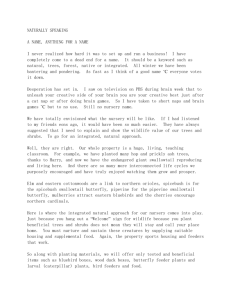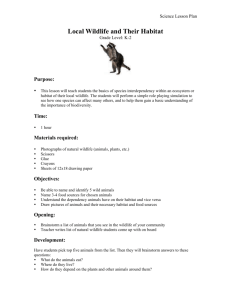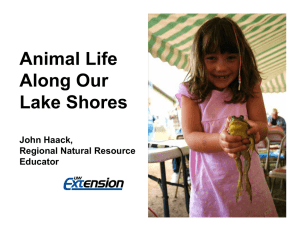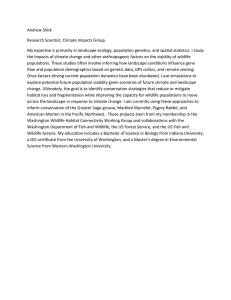Forest Resources:
advertisement
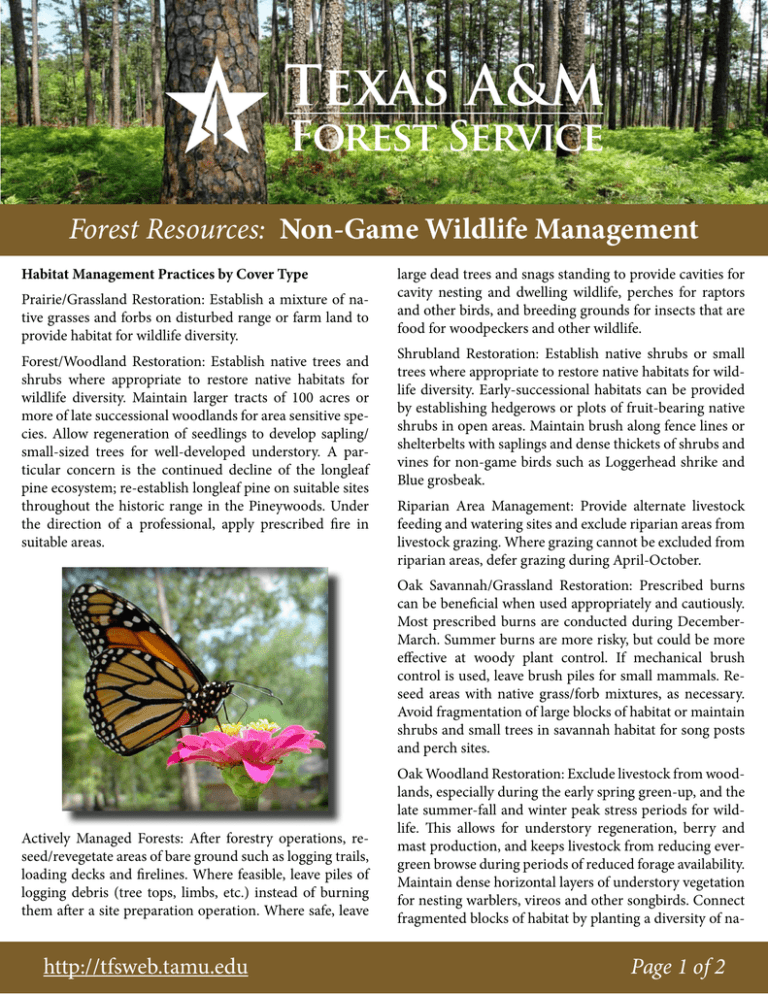
Forest Resources: Non-Game Wildlife Management Habitat Management Practices by Cover Type Prairie/Grassland Restoration: Establish a mixture of native grasses and forbs on disturbed range or farm land to provide habitat for wildlife diversity. Forest/Woodland Restoration: Establish native trees and shrubs where appropriate to restore native habitats for wildlife diversity. Maintain larger tracts of 100 acres or more of late successional woodlands for area sensitive species. Allow regeneration of seedlings to develop sapling/ small-sized trees for well-developed understory. A particular concern is the continued decline of the longleaf pine ecosystem; re-establish longleaf pine on suitable sites throughout the historic range in the Pineywoods. Under the direction of a professional, apply prescribed fire in suitable areas. large dead trees and snags standing to provide cavities for cavity nesting and dwelling wildlife, perches for raptors and other birds, and breeding grounds for insects that are food for woodpeckers and other wildlife. Shrubland Restoration: Establish native shrubs or small trees where appropriate to restore native habitats for wildlife diversity. Early-successional habitats can be provided by establishing hedgerows or plots of fruit-bearing native shrubs in open areas. Maintain brush along fence lines or shelterbelts with saplings and dense thickets of shrubs and vines for non-game birds such as Loggerhead shrike and Blue grosbeak. Riparian Area Management: Provide alternate livestock feeding and watering sites and exclude riparian areas from livestock grazing. Where grazing cannot be excluded from riparian areas, defer grazing during April-October. Oak Savannah/Grassland Restoration: Prescribed burns can be beneficial when used appropriately and cautiously. Most prescribed burns are conducted during DecemberMarch. Summer burns are more risky, but could be more effective at woody plant control. If mechanical brush control is used, leave brush piles for small mammals. Reseed areas with native grass/forb mixtures, as necessary. Avoid fragmentation of large blocks of habitat or maintain shrubs and small trees in savannah habitat for song posts and perch sites. Actively Managed Forests: After forestry operations, reseed/revegetate areas of bare ground such as logging trails, loading decks and firelines. Where feasible, leave piles of logging debris (tree tops, limbs, etc.) instead of burning them after a site preparation operation. Where safe, leave http://tfsweb.tamu.edu Oak Woodland Restoration: Exclude livestock from woodlands, especially during the early spring green-up, and the late summer-fall and winter peak stress periods for wildlife. This allows for understory regeneration, berry and mast production, and keeps livestock from reducing evergreen browse during periods of reduced forage availability. Maintain dense horizontal layers of understory vegetation for nesting warblers, vireos and other songbirds. Connect fragmented blocks of habitat by planting a diversity of na- Page 1 of 2 Forest Resources: Non-Game Wildlife Management tive, fruit-bearing trees and shrubs. Maintain areas with hardwoods (post oak, red oak, water oak, white oak, etc.) with at least 50% canopy cover. Control over-browsing by white-tailed deer, exotic game and livestock. Mid-succession Brush Habitat Enhancement: Promote brush regeneration with prescribed fire and/or mechanical methods that remove the top-growth of woody plants but encourage root sprouting. Use proper grazing management. Providing Supplemental Water Wetland Restoration: Establish water flows and native vegetation in altered coastal and inland wetlands. Well/Trough/Pond with Overflows: Establish additional shallow water supplies through construction of groundlevel wildlife ponds, or adding overflow systems on existing wells and troughs. Protect these areas from livestock use. Providing Supplemental Shelter Brush Piles/Rock Piles: Leave or stack cleared brush and rock to create dens and escape cover for birds, small mammals, reptiles and amphibians. Thickets of Native Brush: Create or maintain thickets of native shrubs/trees for refuge. Snag Maintenance and Creation: Protect snags and deadfall for cavity-dwelling species. Create snags using selective herbicides or girdling undesirable woody plants. Providing Supplemental Food Establish food plots ½ to 1 acre in size by shallow disking and/or sowing native seed-producing food plants for birds (i.e., Sunflower, millet, partridge pea, sesame). Butterfly and Hummingbird Gardens: Establish native wildflowers, trees, shrubs, vines, or cultivated flowers as food sources for butterflies and hummingbirds. Nest Boxes and Perching Platforms/Poles: Provide nest structures for songbirds, owls, small mammals, bats, raptors, herons and other nongame species. Where suitable nest cavities are in short supply due to lack of dead timber snags that provide cavities, artificial nest/roost boxes can be erected to help alleviate these shortages for particular species. Some of the birds and mammals that can benefit from these structures are: bluebirds, chickadees, titmice, prothonotary warbler, wrens, woodpeckers, screech owls, kestrels, wood ducks, squirrels, and bats. The Texas Parks and Wildlife Department Wildscapes Program can furnish additional information regarding number, specifications, placement, and maintenance of these structures for specific species. Feeding Stations: Set up liquid, seed and free-choice feeding stations for resident and migratory birds. These are especially critical during migration and winter months when natural food sources are scarce. http://tfsweb.tamu.edu Page 2 of 2



